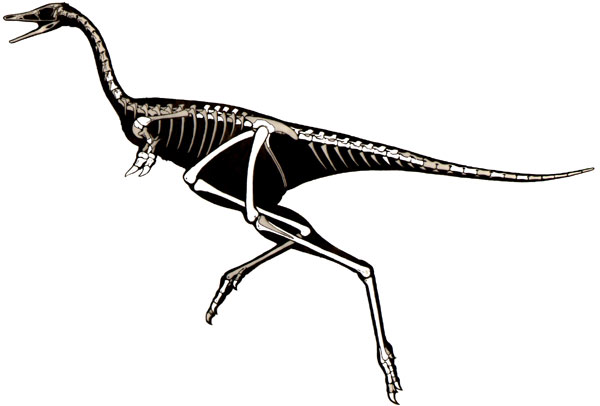Dinosaur's single digit draws world attention
Scientists have discovered a new dinosaur species whose members were similar in size to a parrot but only had one finger. Scientists view that rare solitary digit as evidence that the evolution of dinosaurs was more complex than they first believed.
 |
|
Linhenykus skeletal reconstruction.Scientists say skeletal pieces shed light on evolution. |
The new dinosaur was found in rocks formed from 84 million to 75 million years ago in Linhe, a city near the Yellow River.
The species belongs to a family within the carnivorous dinosaurian group theropods, which later gave rise to modern birds, according to Xu Xing of the Institute of Vertebrate Palaeontology and Paleoanthropology, which is under the Chinese Academy of Sciences.
The new dinosaur, called Linhenykus, "most likely grew to a few feet tall and weighed only as much as a large parrot", said Xu, who led the international team of scientists that discovered the species.
Unlike previously known types of theropods, this dinosaur is unusual in having hands with just one large claw, which may have been used to dig out insects like ants, said the scientists in a report to be published online on Tuesday in the journal Proceedings of the National Academy of Sciences.
The unusual physical attribute makes the specimen the only dinosaur known to have one finger. That uniqueness is what most piques the interest of scientists, Xu said.
He and others believe theropod dinosaurs started with five fingers but evolved in later forms to have only three fingers. Some eventually became birds.
Scientists think that, in the course of evolving into birds, various related dinosaur species gradually lost two of their five fingers, likely in response to changes in the environment.
But in recent decades, with the discovery of more theropods that, like the two-finger Tyrannosaurus, have fewer than three fingers, scientists have come to agree that the evolution of dinosaurs' hands was brought about more by random mutations than by basic adaptive evolution.
"The discovery of the one-fingered dinosaur only reconfirms the fact that digital reduction is a striking evolutionary phenomenon, far more complicated than we've expected," Xu said.
The presence of only one finger in Linhenykus shows that vestigial fingers come and go throughout the evolution of a group. Such changes are not unusual in the evolutionary histories of various animals, according to Jonah Choiniere of the Division of Paleontology at the American Museum of Natural History, who helped to discover the new dinosaur species.
"Vestigial structures, like legs in whales and snakes, may appear and disappear seemingly randomly in the course of evolution," Choiniere said.
The reasons for the loss of the two outer fingers in Linhenykus are unclear, but are likely related to an increased dependence on the first finger, as evidenced by its large size and presumably strong muscle attachments, Xu said.
But after examining the new species' partial skeleton, which includes vertebrae, a forelimb, a partial pelvis and nearly complete hind limbs, Xu and his team surmised that Linhenykus lived with other theropod dinosaurs that were closely related and of a similar size. The new species' unique skeleton, they said, may reflect differences in behavior or foraging strategies.
 0
0 







Go to Forum >>0 Comments